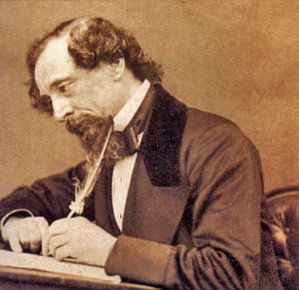
Charles Dickens was the most popular and best-loved novelist of Victorian Britain. He rejoiced in what he called 'that special relationship, personally affectionate and like no other man's' that he shared with his hundreds of thousands of readers.
Central to this popularity was his celebration of the joys of hearth and home as in the famous scene of the Cratchit family's Christmas dinner A Christmas Carol (1843). Many readers also believed that the radiantly happy domestic ending of David Copperfield (1849) reflected Dickens's own personal situation.
In 1858 a great sensation was therefore caused, on both sides of the Atlantic, when it transpired that Dickens was separating from his wife after 20 years of marriage and fathering 10 children by her. Rumors spread that he was having an affair with a young actress called Ellen Ternan who had been performing with his amateur company or, far worse, that he had a relationship with his wife's resident younger sister who chose to remain in his home after the break-down of the marriage.
Dickens's angry denunciation of these rumors in a notice in The Times headed 'Personal' of course only gave them wider publicity as the notice was widely copied in both the British and the American press. Gradually, however, the rumors died down while Catherine herself and Dickens's closest friends all preserved a discreet silence. Ellen simply vanished from public view while Dickens himself embarked on a new career of giving paid public readings from his books all over Britain and also, during 1867/68 in America.
He was everywhere greeted with huge audiences and rapturous enthusiasm. His books continued to sell in vast quantities and his sudden death at the age of 58, plunged the whole English-speaking world into mourning. He was buried in Westminster Abbey where the Dean preached a sermon on the vast and beneficent influence his writings had exercised on society.
Dickens's naming of Ellen Ternan in his will and bequest to her of £1,000 caused some comment but this soon died away. His family and close friends, including John Forster, who wrote a three-volume biography of him, preserved a total silence about his relationship with Ellen during the last twelve years of his life. All references to her were carefully expunged from his surviving letters before publication. Ellen, who was very youthful-looking, knocked 10 years off her age and married a young clergyman called George Wharton Robinson. She bore him two children and helped him to run a boys' school in the South Coast resort of Margate. She gave public readings from Dickens for charity but never spoke about having known him personally. She died a widow in 1914.
Twelve years earlier the International Dickens Fellowship had been founded, dedicated to 'spreading the love of humanity, the keynote of all his [Dickens's] works.' It was also dedicated to preserving his memory as that of a truly good and great man. Ellen's name was, of course, completely taboo in Fellowship circles.
The longest surviving of Dickens's children and the only successful one, Henry, became a distinguished judge. Acting as guardian-in-chief of his father's memory he was quick to crush any scandalous rumour that might emerge. But he could not stop the 1928 publication of a very bad novel called This Side Idolatry which caused a huge sensation in the press by depicting Dickens as falling passionately in love with Ellen. In 1934 Henry died and Thomas Wright, an elderly biographer with a reputation for probing into his subjects' love-lives, felt free to publish a life of Dickens in which he claimed to have been told some 40 years earlier, by a clergyman long since dead, that Ellen had once confessed to him that she had been Dickens's mistress but now 'loathed the very thought of the intimacy'.
Wright's startling revelation was fiercely contested by the Dickens Fellowship which seized on the fact that he could produce no documentary evidence to support his story. Five years later, however, Gladys Storey, who had befriended Dickens's artist-daughter Kate Perugini in her old age, published a book called Dickens and Daughter. In it Kate, who had died in 1929, was reported as having stated categorically that Dickens and Ellen had been lovers and that they had had a son who had died in infancy.
This revelation caught the interest of the great American critic Edmund Wilson who in 1941 published a hugely influential essay called 'The Two Scrooges' examining Dickens as a man who led a double life during the last twelve years of his life. Wilson had no doubt that Dickens and Ellen were lovers and argued that this had a profound influence on Dickens's later novels with Ellen herself being reflected in his later heroines notably Estella in Great Expectations.
American scholars, inspired by Wilson, began examining surviving Dickens letters, the 1867 diary he lost in America and other documents, using infra-red photography to recover passages about Ellen that had been blotted out. Meanwhile in England Sir Felix Aylmer, a distinguished actor with a passion for detective fiction, discovered that Dickens had paid the rent for a cottage in Slough, not far from London, where he often visited her. Aylmer also believed that he had discovered the supposed short-lived love-child but was quickly shown to have misread the relevant records. Gradually, more and more about Ellen and her connection with Dickens came to light and in 1990 Claire Tomalin published a best-selling biography of her called The Invisible Woman.
To this day, however, no positive proof has emerged that Dickens and Ellen were indeed lovers and some biographers, notably Peter Ackroyd, have argued that the relationship was a non-physical one, answering to certain strong psychological and emotional needs in Dickens himself. Others, however, including many fully-paid-up members of the Dickens Fellowship, now firmly believe that Dickens and Ellen were indeed lovers. The subject seems destined to remain one of endless fascination and debate.
Michael Slater is the author of the new book The Great Charles Dickens Scandal.
